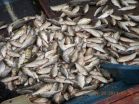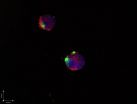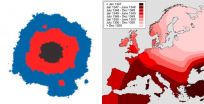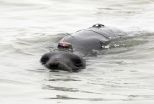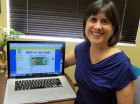Live images from the nano-cosmos
Researchers watch layers of football molecules grow
2014-11-05
(Press-News.org) Using DESY's ultrabright X-ray source PETRA III, researchers have observed in real-time how football-shaped carbon molecules arrange themselves into ultra-smooth layers. Together with theoretical simulations, the investigation reveals the fundamentals of this growth process for the first time in detail, as the team around Sebastian Bommel (DESY and Humboldt Universität zu Berlin) and Nicola Kleppmann (Technische Universität Berlin) reports in the scientific journal Nature Communications. This knowledge will eventually enable scientists to tailor nanostructures for certain applications from these carbon molecules, which play an increasing role in the promising field of plastic electronics. The team consisted of scientists from Humboldt-Universität zu Berlin, Technische Universität Berlin, Universität Tübingen and DESY.
The scientists studied so called buckyballs. Buckyballs are spherical molecules, which consist of 60 carbon atoms (C60). Because they are reminiscent of American architect Richard Buckminster Fuller's geodesic domes, they were christened buckminsterfullerenes or "buckyballs" for short. With their structure of alternating pentagons and hexagons, they also resemble tiny molecular footballs.
Using DESY's X-ray source PETRA III, the researchers observed how buckyballs settle on a substrate from a molecular vapour. In fact, one layer after another, the carbon molecules grow predominantly in islands only one molecule high and barely form tower-like structures. "The first layer is 99% complete before 1% of the second layer is formed," explains DESY researcher Bommel, who is completing his doctorate in Prof. Stefan Kowarik's group at the Humboldt Universität zu Berlin. This is how extremely smooth layers form.
"To really observe the growth process in real-time, we needed to measure the surfaces on a molecular level faster than a single layer grows, which takes place in about a minute," says co-author Dr. Stephan Roth, head of the P03 measuring station, where the experiments were carried out. "X-ray investigations are well suited, as they can trace the growth process in detail."
"In order to understand the evolution of the surface morphology at the molecular level, we carried out extensive simulations in a non-equilibrium system. These describe the entire growth process of C60 molecules into a lattice structure," explains Kleppmann, PhD student in Prof. Sabine Klapp's group at the Institute of Theoretical Physics, Technische Universität Berlin. "Our results provide fundamental insights into the molecular growth processes of a system that forms an important link between the world of atoms and that of colloids."
Through the combination of experimental observations and theoretical simulations, the scientists determined for the first time three major energy parameters simultaneously for such a system: the binding energy between the football molecules, the so-called "diffusion barrier," which a molecule must overcome if it wants to move on the surface, and the Ehrlich-Schwoebel barrier, which a molecule must overcome if it lands on an island and wants to hop down from that island.
"With these values, we now really understand for the first time how such nanostructures come into existence," stresses Bommel. "Using this knowledge, it is conceivable that these structures can selectively be grown in the future: How must I change my temperature and deposition rate parameters so that an island of a particular size will grow. This could, for example, be interesting for organic solar cells, which contain C60." The researchers intend to explore the growth of other molecular systems in the future using the same methods.
INFORMATION:
Deutsches Elektronen-Synchrotron DESY is the leading German accelerator centre and one of the leading in the world. DESY is a member of the Helmholtz Association and receives its funding from the German Federal Ministry of Education and Research (BMBF) (90 per cent) and the German federal states of Hamburg and Brandenburg (10 per cent). At its locations in Hamburg and Zeuthen near Berlin, DESY develops, builds and operates large particle accelerators, and uses them to investigate the structure of matter. DESY's combination of photon science and particle physics is unique in Europe.
Reference
"Unravelling the multilayer growth of the fullerene C60 in real-time"; Sebastian Bommel, Nicola Kleppmann et al.; Nature Communications, 2014; DOI: 10.1038/ncomms6388
[Attachments] See images for this press release:
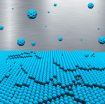
ELSE PRESS RELEASES FROM THIS DATE:
2014-11-05
Researchers at the Cognition and Brain Plasticity group of the Bellvitge Biomedical Research Institute (IDIBELL) and the University of Barcelona have been tracking the traces of implicit and explicit memories of fear in human. The study has been published in the journal Neurobiology of Learning and Memory and describes how in a context of fear, our brain differently encodes contextual memory of a negative event (the place, what we saw...) and emotional response associated.
The study measures electrodermal activity of 86 individuals in a fearful generated in the laboratory ...
2014-11-05
Bethesda, MD (Nov. 5, 2014) — Up to 15 percent of the general adult population is affected by irritable bowel syndrome (IBS), and most patients struggle to find effective drug therapy. A new guideline from the American Gastroenterological Association (AGA) provides these patients and their physician's guidance. The new guideline and accompanying technical review have been published in Gastroenterology, the official journal of the AGA Institute.
"Because no IBS therapy is uniformly effective, many patients describe a history of a variety of treatments alone or in ...
2014-11-05
What sounds counter-intuitive to an activity commonly perceived as quiet is the broad recommendation of scientists at Michigan State University (MSU) recommending that small-scale fishing in the world's freshwater bodies must have a higher profile to best protect global food security.
In this month's journal Global Food Security, scientists note that competition for freshwater is ratcheting up all over the world for municipal use, hydropower, industry, commercial development, and irrigation. Rivers are being dammed and rerouted, lakes and wetlands are being drained, fish ...
2014-11-05
Noonan syndrome is a rare disease that is characterised by a set of pathologies, including heart, facial and skeletal alterations, pulmonary stenosis, short stature, and a greater incidence of haematological problems (mainly juvenile myeloid leukaemia, or childhood leukaemia). There is an estimated incidence of 1 case for every 1,000–2,500 births, and calculations show some 20,000–40,000 people suffer from the disease in Spain. From a genetic point of view, this syndrome is associated to mutations in 11 different genes —the K-Ras gene among them— ...
2014-11-05
PATIENTS with a specific type of oesophageal cancer survived longer when they were given the latest lung cancer drug, according to trial results being presented at the National Cancer Research Institute (NCRI) Cancer Conference today (Wednesday).
Up to one in six patients with oesophageal cancer were found to have EGFR duplication in their tumour cells and taking the drug gefitinib, which targets this fault, boosted their survival by up to six months, and sometimes beyond.
This is the first treatment for advanced oesophageal cancer shown to improve survival in patients ...
2014-11-05
Fatih Uckun, Jianjun Cheng and their colleagues have taken the first steps towards developing a so-called "smart bomb" to attack the most common and deadly form of childhood cancer — called B-lineage acute lymphoblastic leukemia (ALL).
In a November study in the new peer-reviewed, open-access journal EBioMedicine, they describe how this approach could eventually prove lifesaving for children who have relapsed after initial chemotherapy and face a less than 20 percent chance of long-term survival.
"We knew that we could kill chemotherapy-resistant leukemia cells ...
2014-11-05
The current Ebola outbreak shows how quickly diseases can spread with global jet travel.
Yet, knowing how to predict the spread of these epidemics is still uncertain, because the complicated models used are not fully understood, says a University of California, Berkeley biophysicist.
Using a very simple model of disease spread, Oskar Hallatschek, assistant professor of physics, proved that one common assumption is actually wrong. Most models have taken for granted that if disease vectors, such as humans, have any chance of "jumping" outside the initial outbreak area ...
2014-11-05
Researchers using a new type of tracking device on female elephant seals have discovered that adding body fat helps the seals dive more efficiently by changing their buoyancy.
The study, published November 5 in the Proceedings of the Royal Society B, looked at the swimming efficiency of elephant seals during their feeding dives and how that changed in the course of months-long migrations at sea as the seals put on more fat. The results showed that when elephant seals are neutrally buoyant--meaning they don't float up or sink down in the water--they spend less energy ...
2014-11-05
A University of Oregon researcher wants those "R" words to resonate among young athletes. They are key terms used in an online educational tool designed to teach coaches, educators, teens and parents about concussions.
Brain 101: The Concussion Playbook successfully increased knowledge and attitudes related to brain injuries among students and parents in a study that compared its use in 12 high schools with the usual care practices of 13 other high schools during the fall 2011 sports season. The findings are online ahead of print in the Journal of Adolescent Health.
Participants, ...
2014-11-05
A study led by a researcher from Plymouth University in the UK, has discovered that the inhibition of a particular mitochondrial fission protein could hold the key to potential treatment for Parkinson's Disease (PD).
The findings of the research are published today, 5th November 2014, in Nature Communications.
PD is a progressive neurological condition that affects movement. At present there is no cure and little understanding of why some people get the condition. In the UK one on 500 people, around 127,000, have PD.
The debilitating movement symptoms of the disease ...
LAST 30 PRESS RELEASES:
[Press-News.org] Live images from the nano-cosmos
Researchers watch layers of football molecules grow


